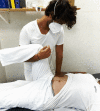Practice of Peritoneal Adhesions in Osteopathic Medicine: Part 2
- PMID: 37554375
- PMCID: PMC10406449
- DOI: 10.7759/cureus.43092
Practice of Peritoneal Adhesions in Osteopathic Medicine: Part 2
Abstract
Peritoneal adhesions are an unwanted and frequent event following abdominal surgery, with a response rate that can reach 100%. The adhesions can be symptomatic, becoming a source of pain and discomfort for the patient, or asymptomatic, with possible chronic or acute visceral dysfunction. The article reviews what the diagnostic strategies are and discusses what could be the causes that lead to chronic pain in the presence of adhesions. The text reports the knowledge of the literature on the manual treatment of adhesions and illustrates possible symptoms that are not easily recognized by the clinician. To conclude, the article proposes osteopathic manual approaches derived from clinical experience and from what has been explained about the formation of peritoneal adhesions. Research must make further efforts to identify not only the causes triggering the formation of peritoneal neogenesis but also seek the most appropriate non-invasive treatments to help the patient.
Keywords: fascia; manual therapy; myofascial; osteopathic manipulation; osteopathy; peritoneal adhesions; surgery.
Copyright © 2023, Bordoni et al.
Conflict of interest statement
The authors have declared that no competing interests exist.
Figures




Similar articles
-
Peritoneal Adhesions in Osteopathic Medicine: Theory, Part 1.Cureus. 2023 Jul 26;15(7):e42472. doi: 10.7759/cureus.42472. eCollection 2023 Jul. Cureus. 2023. PMID: 37502471 Free PMC article. Review.
-
The Other Side of the Fascia: Visceral Fascia, Part 2.Cureus. 2019 May 10;11(5):e4632. doi: 10.7759/cureus.4632. Cureus. 2019. PMID: 31312558 Free PMC article. Review.
-
Diagnosis and management of complications following pelvic organ prolapse surgery using a synthetic mesh: French national guidelines for clinical practice.Eur J Obstet Gynecol Reprod Biol. 2024 Mar;294:170-179. doi: 10.1016/j.ejogrb.2024.01.015. Epub 2024 Jan 17. Eur J Obstet Gynecol Reprod Biol. 2024. PMID: 38280271 Review.
-
Proposal for Manual Osteopathic Treatment of the Phrenic Nerve.Cureus. 2024 Apr 11;16(4):e58012. doi: 10.7759/cureus.58012. eCollection 2024 Apr. Cureus. 2024. PMID: 38606024 Free PMC article. Review.
-
Osteopathic Palpation of the Heart.Cureus. 2021 Mar 30;13(3):e14187. doi: 10.7759/cureus.14187. Cureus. 2021. PMID: 33816036 Free PMC article. Review.
Cited by
-
Fascial Manual Medicine: The Concept of Fascial Continuum.Cureus. 2025 Apr 12;17(4):e82136. doi: 10.7759/cureus.82136. eCollection 2025 Apr. Cureus. 2025. PMID: 40226146 Free PMC article. Review.
References
Publication types
LinkOut - more resources
Full Text Sources
